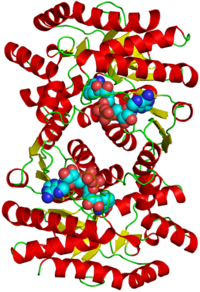
Photo from wikipedia
The model nonapeptide AAARAAKAG* (* indicates amide) is used to explore N-Cα bond fragmentation under CID-MS conditions. Neighboring group participation and the effect of positioning of Lys and Arg residues… Click to show full abstract
The model nonapeptide AAARAAKAG* (* indicates amide) is used to explore N-Cα bond fragmentation under CID-MS conditions. Neighboring group participation and the effect of positioning of Lys and Arg residues on N-Cα bond cleavage is established using a library of synthetic peptide analogues. The importance of the Arg residue at position 4 and the i to i+3 spacing between Arg and Lys residues in determining the formation of the N-Cα bond cleaved product ions (cn) is demonstrated by a comparative MS study of positional variants in analogue peptides. The effect of shortening of the Lys side chain has been established using ornithine (Orn) and diaminobutyric acid (Dab) analogues. The involvement of the Lys residue in mediating the N-Cα bond cleavage is further probed using Nε-dimethyl and isotopically labeled 15Nα, ε lysine residues. MSn experiments reveal that the c6 ion originates from a doubly charged dehydrated b8 ion [b8-18]2+. The mechanism of this unusual fragmentation process has been probed by using position 8 analogues (Gly, Ala, and Aib). A plausible mechanism is proposed for the origin of the c6 ion, which involves C-terminus lactam formation followed by transannular cyclization and dehydration. The results presented in this study highlight the role of reactive side chain functionalities in promoting noncanonical fragmentation pathways.
Journal Title: Journal of the American Society for Mass Spectrometry
Year Published: 2022
Link to full text (if available)
Share on Social Media: Sign Up to like & get
recommendations!